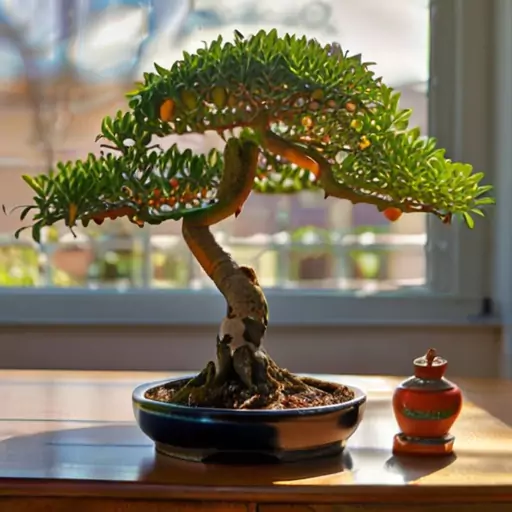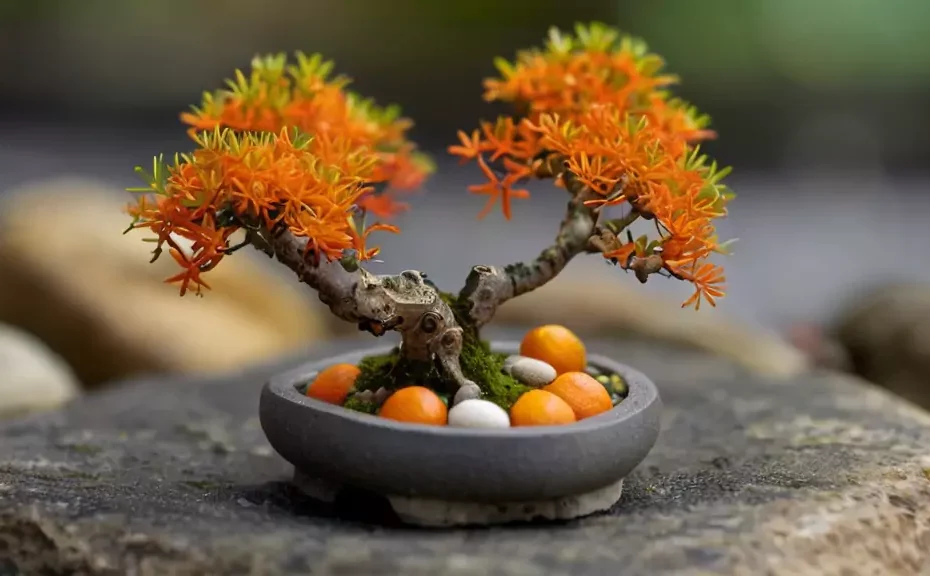The bonsai orange tree
Bonsai is the ancient art of cultivating miniature trees in containers. These tiny trees, meticulously shaped and cared for, capture the essence of a full-grown tree in a compact form.
The image you sent me showcases a bonsai orange tree, a particularly captivating variety of bonsai. Not only do these miniature citrus trees boast the characteristic miniature size and intricate shaping of bonsai, but they also produce tiny, edible oranges!
Owning a bonsai orange tree is a unique way to bring a touch of nature and a conversation starter into your home. It’s a rewarding challenge for plant enthusiasts, offering the satisfaction of nurturing a miniature world and the occasional zesty treat.
What is a Bonsai Orange Tree?
Bonsai enthusiasts may be familiar with the Kinzu, a charming miniature citrus tree cultivated in the art of bonsai. But what exactly is a bonsai orange tree, and what makes the Kinzu so special?
Bonsai is the ancient Japanese art of growing and shaping miniature trees in containers. These miniature trees are not genetically dwarfed; instead, they are meticulously pruned and trained to maintain their small size and desired shape.
The Alluring Kinzu: A Miniature Fruiting Wonder
The Kinzu, also known as the Kumquat Bonsai, is a popular choice for bonsai enthusiasts. It’s a variety of the Kumquat, a small citrus fruit tree belonging to the Citrus genus.
Standing at just 20 to 50 centimeters (8 to 20 inches) tall when fully grown, the Kinzu boasts several characteristics that make it a captivating addition to any home:
- Cute and Compact: As a bonsai, the Kinzu retains the lush green foliage and miniature branches of a full-sized orange tree, but in an adorable, miniature form.
- Evergreen Beauty: The Kinzu’s leaves stay green year-round, adding a touch of life and vibrancy to your indoor space, even during the winter months.
- Sweetly Scented Blooms: During springtime, the Kinzu graces its admirers with fragrant white flowers, adding a delightful touch to its visual appeal.
- Tiny, Tangy Treats: Perhaps the most delightful feature of the Kinzu is its ability to produce miniature fruits. These tiny oranges, typically smaller than a marble, are not only edible but also quite tangy and flavorful, offering a delightful surprise for patient bonsai growers.
Care Guide for Bonsai Orange Trees



1. Sun-loving citrus: Just like their larger relatives, bonsai orange trees crave sunshine. Aim for at least 6 hours of direct sunlight daily, especially during their active growing seasons of spring and summer. South-facing windows are ideal locations for your miniature citrus tree during the colder winter months. If you live in a climate with harsh winters, you may need to supplement natural light with grow lights to ensure your bonsai orange tree gets enough sunlight throughout the year.
2. Water wisely: Unlike some houseplants that prefer constantly moist soil, bonsai orange trees are susceptible to root rot if overwatered. To avoid this, water your tree only when the top inch of soil feels dry to the touch. Use a watering can with a long spout to direct water at the base of the plant, allowing excess water to drain freely from the pot’s drainage holes. Avoid getting water on the leaves and flowers, as this can promote fungal diseases.
3. Potting mix matters: Bonsai orange trees thrive in well-draining soil mixes that allow for proper aeration and prevent waterlogging. A commercial mix specifically designed for citrus plants is a good option, as it often offers the appropriate drainage and slightly acidic pH level that these trees prefer. When repotting your bonsai orange tree every 2-3 years, choose a pot only slightly larger than the root ball to avoid overwatering.
4. Feed for success: During the spring and summer growing seasons, a light feeding every two weeks with a fertilizer formulated for citrus trees will keep your bonsai orange tree happy and healthy. Be sure to dilute the fertilizer according to the package instructions and avoid overfeeding, as this can damage the roots. Opt for organic fertilizers whenever possible, as they are less likely to harm your tree or the environment.
5. Snip, snap, shape!: Regular pruning is essential for maintaining the size and desired shape of your bonsai orange tree. Pinch back new growth regularly to encourage branching and develop a bushier, fuller tree. Use sharp bonsai shears to prune larger branches and maintain the overall form. Remember, it’s always best to start slow when pruning, as you can always remove more later if needed.
6. Enjoy the sweet smell of blooms and tiny fruits: Bonsai orange trees are not only visually appealing but also fragrant. In spring, they produce beautiful white flowers that fill the surrounding air with their sweet scent. These fragrant blooms eventually give way to the development of small, immature oranges. While these miniature fruits are not typically suitable for eating, they add to the visual appeal of your bonsai and can be a source of pride for the patient bonsai enthusiast.
7. Beware of common pests and diseases: Just like other citrus trees, bonsai orange trees can be susceptible to pests like aphids, scale, and mealybugs, as well as fungal diseases like powdery mildew. Regularly inspect your tree for signs of infestation or disease. If you notice any problems, address them promptly with insecticidal soap, neem oil solution, or fungicide, following the instructions on the product label carefully.
8. Temperature matters: Bonsai orange trees prefer warm temperatures, ideally between 65-80 degrees Fahrenheit. Avoid placing your tree near cold drafts, heat sources, or air conditioning vents, as these can cause stress and negatively impact its health. During winter, you may need to move your bonsai orange tree indoors to a protected location, such as a sunroom or greenhouse, where it can receive sufficient sunlight and remain at moderate temperatures.
9. Humidity matters too: Bonsai orange trees prefer moderate humidity levels, around 50-60%. If the air in your home is dry, especially during winter, you can increase humidity around your tree using a humidifier or placing it on a pebble tray filled with water. Be sure to keep the water level below the top of the pebbles to avoid the roots sitting in water.
How to Bonsai Orange Trees


Choosing a Style:
The first step in shaping your bonsai orange tree is to choose a style. This will influence all future pruning and wiring decisions. Here are some popular styles for bonsai orange trees:
- Formal Upright: This classic style features a straight trunk with branches evenly spaced on either side. It conveys a sense of strength and formality.
- Informal Upright: Similar to the formal upright, but with a slightly leaning trunk and more asymmetrical branching. This style creates a more natural and dynamic feel.
- Slanting: The tree leans at an angle, often due to the influence of wind or uneven terrain in its natural environment. This style can be dramatic and eye-catching.
- Cascade: The branches cascade down below the base of the pot, creating a flowing and graceful form. This style requires careful wiring and branch positioning.
- Semi-cascade: Similar to the cascade, but the branches only cascade partially down the pot. This style is a good compromise between a cascade and a more upright style.
Shaping Techniques:
Once you’ve chosen a style, you can begin shaping your bonsai orange tree using pruning and wiring techniques.
- Pruning: Pruning involves cutting away branches to control the size and shape of the tree. It’s important to know your desired style before pruning, as each style requires specific cuts.
- Wiring: Bonsai wire is a thin, flexible wire used to bend and position branches. Wiring should be done carefully to avoid damaging the bark. As the branches grow thicker, the wire needs to be adjusted or removed to avoid girdling, which can restrict growth.
Caring for Bonsai Orange Trees
While the Kinzu is a relatively low-maintenance bonsai option, here are a few tips to keep your miniature citrus tree thriving:
- Sun-loving citrus: Just like their larger relatives, bonsai orange trees love sunshine. Aim for at least 6 hours of direct sunlight daily, especially during spring and summer. South-facing windows are ideal locations for your miniature citrus tree during winter.
- Water wisely: Unlike some houseplants, bonsai orange trees don’t need constantly moist soil. Overwatering can lead to root rot, so water only when the top inch of soil feels dry to the touch. Use a watering can with a long spout to water directly at the base of the plant, avoiding the leaves and flowers.
- Potting mix matters: Bonsai orange trees prefer well-draining soil mixes. A good option is a commercial mix specifically designed for citrus plants, which offers proper drainage and is slightly acidic, as these trees prefer. When repotting every 2-3 years, choose a pot only slightly larger than the root ball to avoid overwatering.
- Feed for success: During spring and summer, a light feeding every two weeks with a fertilizer formulated for citrus trees will keep your bonsai orange tree happy and healthy. Be sure to dilute the fertilizer according to the package instructions and avoid overfeeding, which can damage the roots.
- Snip, snap, shape!: Regular pruning is key to maintaining the size and shape of your bonsai orange tree. Pinch back new growth to encourage branching, and prune larger branches with sharp bonsai shears to maintain the desired form. Remember, it’s always best to start slow when pruning, as you can always remove more later if needed.
- Enjoy the sweet smell of blooms: Bonsai orange trees not only produce tiny oranges, but also fragrant white flowers in spring. To encourage blooming, keep your tree healthy and provide it with plenty of sunlight.
- Beware of common pests: Just like other citrus trees, bonsai orange trees can be susceptible to pests like aphids and scale. If you notice any pests, treat them promptly with an insecticidal soap or neem oil solution.
- Temperature matters: Bonsai orange trees prefer warm temperatures, ideally between 65-80 degrees Fahrenheit. Avoid placing your tree near cold drafts or heat sources. During winter, you may need to move it indoors to a protected location.
- Humidity matters too: Bonsai orange trees prefer moderate humidity levels, around 50-60%. If the air in your home is dry, you can increase humidity by using a humidifier or placing your tree on a pebble tray filled with water.
Additional tips for caring for your bonsai orange tree:
Rotate your tree regularly: This will help ensure that all sides of the tree receive equal sunlight and grow evenly.
Don’t repot too often: Bonsai orange trees don’t need to be repotted as frequently as other houseplants. Every 2-3 years is usually sufficient.
Enjoy the journey!: Bonsai is an art form, and caring for your bonsai orange tree is a creative and rewarding experience. Take the time to appreciate the beauty of your miniature citrus tree and enjoy the process of watching it grow and change over time.
Conclusion
Bonsai orange trees bring the joy of citrus to even the smallest spaces. Imagine a miniature tree, meticulously cared for, bursting with fragrant blossoms and bearing tiny, edible oranges. It’s a testament to patience and dedication, a living piece of art that rewards you year after year.
Sure, they need a bit of extra attention to sunlight, water, and pruning, but the satisfaction is unparalleled. So, if you’re looking for a captivating challenge and a touch of citrus magic in your home, a bonsai orange tree might just be the perfect addition. Remember, with a little love and care, your miniature citrus masterpiece can thrive for years to come.
